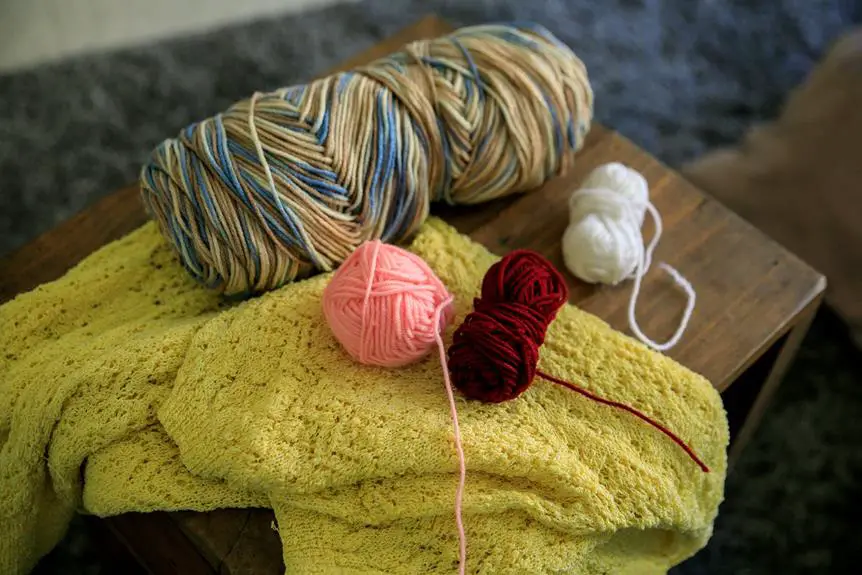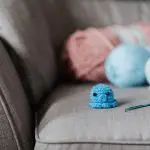Looking for the absolute best fabric for crocheting? You've come to the right place.
Understanding the characteristics of different fabrics can help you master the art of crocheting. From the texture to the weight, the choice of fabric can greatly impact the outcome of your crochet project.
By carefully considering factors such as fiber content and flexibility, you can ensure that you select the perfect fabric for your next creation.
Let's explore the various popular fabrics for crocheting and delve into the factors that should guide your decision.
Whether you're working on a delicate lace project or a cozy blanket, choosing the right fabric is crucial for achieving mastery in your crocheting endeavors.
Key Takeaways
- Durability and flexibility are important factors to consider when choosing a fabric for crocheting.
- Cotton is popular for its softness and breathability, making it ideal for comfortable garments and accessories.
- Acrylic yarn is favored for its durability and colorfastness, making it practical for frequently used items.
- Wool yarn offers warmth and elasticity, making it suitable for winter wear and accessories.
Characteristics of Crochet Fabrics
When choosing the best fabric for crocheting, you should consider the durability and flexibility of the material. Different crochet fabric types offer varying textures and weights, each suitable for specific projects. The texture of the fabric affects the final appearance and feel of the crochet piece, while the weight determines the drape and heaviness of the finished product.
Crochet fabric types include cotton, wool, acrylic, and blends of these materials. Cotton yarn is a popular choice due to its durability, breathability, and ability to hold its shape well. Additionally, it's available in various weights, making it versatile for different projects.
Wool yarn offers warmth and elasticity, making it suitable for creating winter wear and accessories. Acrylic yarn is known for its affordability, easy maintenance, and wide range of colors and textures, making it ideal for beginners and those on a budget.
Understanding the texture and weight of different crochet fabric types allows you to select the most suitable material for your project, ensuring that your finished piece meets your expectations in terms of both appearance and functionality.
Popular Fabrics for Crocheting
When it comes to crocheting, cotton is popular for its softness and breathability, making it ideal for creating comfortable garments and accessories.
On the other hand, acrylic yarn is favored for its durability and colorfastness, making it a practical choice for items that will see frequent use and washing.
These two fabrics offer distinct benefits, catering to different needs and preferences within the crafting community.
Cotton for Softness
For crocheting, you should choose cotton for its softness and versatility. When comparing cotton to acrylic, cotton yarn tends to be softer, making it a great choice for projects where comfort is a priority. Additionally, cotton is a breathable fabric, making it suitable for wearables and accessories.
When choosing yarn weight for your crochet project, consider using a lighter weight cotton yarn for delicate items like lace doilies or a heavier weight for durable dishcloths or sturdy bags. The softness of cotton makes it pleasant to work with, and it drapes beautifully, making it a popular choice for garments and home decor items.
Acrylic for Durability
You'll find that acrylic is a popular choice for crocheting due to its durability and affordability. Acrylic yarn has several pros and cons compared to natural fibers:
- Durability: Acrylic yarn is highly durable, making it suitable for frequently used items like blankets and sweaters.
- Affordability: It's more budget-friendly than natural fibers, allowing you to create larger projects without breaking the bank.
- Easy Care: Acrylic yarn is machine washable and dries quickly, making it convenient for everyday use.
- Color Variety: Acrylic yarn comes in a wide range of vibrant colors, allowing for endless creative possibilities.
- Hypoallergenic: Unlike some natural fibers, acrylic yarn is hypoallergenic, making it suitable for individuals with sensitivities.
When considering acrylic vs natural fibers, acrylic's durability and affordability make it a practical choice for many crocheters.
Factors to Consider When Choosing Fabric
Considering the texture, weight, and stretch of the fabric is crucial when choosing the best material for crocheting.
Fabric weight and drape play a significant role in the outcome of your crocheted project. Lighter weight fabrics generally work well for delicate, lacy designs, while heavier fabrics are better suited for sturdy, structured items.
The drape of the fabric also affects how the finished piece will hang and move. When selecting a fabric, it's important to consider the color and texture suitability for the intended project. The color of the fabric can greatly impact the overall look of the crocheted item, while the texture can add depth and visual interest.
Additionally, the texture of the fabric can affect the ease of crocheting and the final appearance of the project. A smooth, even texture might be ideal for intricate stitch work, while a textured fabric could add dimension to simple stitches.
Best Fabric for Different Crochet Projects
When selecting fabric for different crochet projects, it's essential to match the fabric weight and texture to the specific type of item you're creating. Different fabric types are suitable for various crochet projects. Consider the following when choosing fabric for your crochet projects:
- Cotton: Ideal for creating dishcloths, summer tops, and lightweight blankets due to its absorbency and breathability.
- Wool: Perfect for making cozy winter wear such as hats, scarves, and sweaters because of its warmth and elasticity.
- Acrylic: Great for crafting durable and easy-to-care-for items like amigurumi toys, afghans, and baby clothes.
- Bamboo: Suitable for crafting delicate, drapey shawls, and garments as it has a luxurious feel and beautiful sheen.
- Silk: Perfect for making elegant, luxurious items like evening wear, lacy wraps, and accessories due to its lustrous and smooth texture.
Matching the fabric to the project ensures that your crochet items not only look great but also serve their intended purpose effectively. Keep in mind the characteristics of each fabric type to achieve the best results in your crochet projects.
Tips for Working With Different Fabrics
To successfully work with different fabrics in your crochet projects, it is important to consider the unique characteristics of each fabric type and how they will impact the final outcome of your creations. When working with silk, keep in mind that it is a delicate and luxurious fabric that requires gentle handling. Its smooth texture adds an elegant drape to your crochet pieces, making it perfect for creating lightweight, graceful items such as scarves or shawls. Wool, on the other hand, offers a wide range of color options and is known for its warmth and resilience. Its natural elasticity also makes it suitable for various crochet projects. When exploring different textures, remember that each texture can add depth and visual interest to your creations. Consider using a variety of textures to create intricate and visually appealing designs. Below is a table summarizing some key points to keep in mind when working with different fabrics in your crochet projects:
| Fabric | Characteristics |
|---|---|
| Silk | Delicate, smooth, elegant drape |
| Wool | Wide color options, warmth, resilience |
| Different Textures | Add depth and visual interest |
| Color Options | Varies based on fabric type |
Where to Find Quality Crocheting Fabrics
You can find quality crocheting fabrics at various locations, including yarn shops and online retailers, local craft stores, and specialty fabric shops.
Each option offers a unique selection of materials, colors, and textures to suit your crocheting needs.
Consider exploring these different sources to discover the best fabrics for your next project.
Yarn Shops and Online
First, explore local yarn shops and online retailers to find quality crocheting fabrics. Local yarn shops offer a personalized experience, allowing you to feel the texture and assess the quality of the yarn. Online retailers provide convenience and a wide range of options, often at competitive prices. Consider the following when searching for quality crocheting fabrics:
- Seek out specialty yarn shops for unique and artisanal yarns, adding a personal touch to your projects.
- Look for online retailers that offer a variety of yarn weights, fibers, and colors, providing endless possibilities for your crocheting endeavors.
- Check for reviews and ratings to ensure the reliability and quality of the yarn before making a purchase.
- Join online communities and forums to gather recommendations and insights from fellow crocheters about reputable online retailers.
- Take advantage of sales and promotions offered by both local yarn shops and online retailers to make the most of your budget while acquiring premium crocheting fabrics.
Local Craft Stores
When looking for quality crocheting fabrics, consider visiting local craft stores, where you can find a diverse selection of yarns and fibers. Local workshops and crochet communities often collaborate with these stores, ensuring a wide range of high-quality materials.
Many craft stores specialize in fiber arts, offering unique and luxurious yarn options that may not be readily available online. These stores also provide the opportunity to physically assess and compare different yarn textures, colors, and weights, which is essential for intricate crochet projects.
Additionally, local craft stores frequently host events and classes, creating a supportive environment for crocheters to learn, share ideas, and expand their skills. By engaging with these stores, you can gain valuable insights into yarn selection and benefit from the expertise of fellow crocheting enthusiasts.
Specialty Fabric Shops
Visiting specialty fabric shops to find quality crocheting fabrics allows you to explore a curated selection of premium yarns and fibers, offering unique and luxurious options for your crochet projects.
Specialty yarns and unique fibers found in these shops can elevate your crochet techniques, inspiring creativity and enhancing the overall quality of your work.
These shops often provide a wide range of color inspiration, from rich, vibrant hues to delicate pastels, allowing you to find the perfect palette for your next project.
Moreover, browsing through these specialty shops can spark new pattern ideas, as they often showcase intricate and innovative designs that can add a fresh dimension to your crocheting endeavors.
Ultimately, the experience of visiting a specialty fabric shop goes beyond purchasing materials; it's an opportunity for immersion in a world of premium resources and endless creative possibilities.
Frequently Asked Questions
Can I Use the Same Fabric for Crocheting a Blanket as I Would for Crocheting a Sweater?
Yes, you can use the same fabric for crocheting a blanket as for crocheting a sweater, but consider different fabric types for each. Silk works well for sweaters, while wool is suitable for blankets.
Are There Any Fabrics That Are Not Recommended for Crocheting, and Why?
Avoid using stretchy or slippery fabrics like satin or silk for crocheting, as they can be difficult to work with and may not hold their shape well. Choose sturdy, non-stretchy fabrics like cotton or wool for blankets, and lighter, drapier fabrics like bamboo or alpaca for sweaters.
How Do I Know if a Fabric Is Suitable for Crocheting Delicate Lace Patterns?
To determine if a fabric is suitable for crocheting delicate lace patterns, consider its stretchiness, durability, and suitability for outdoor use. Select non-stretchy fabrics for lace, like cotton or silk, but use special techniques for stretchy fabrics.
Are There Any Special Techniques or Considerations for Crocheting With Stretchy Fabrics?
When crocheting with stretchy fabrics, consider using a larger crochet hook to accommodate the fabric's elasticity. Opt for a durable yarn that complements the fabric's stretch, and employ special techniques to ensure your project retains its shape.
What Are the Best Fabrics for Crocheting Items That Will Be Used Outdoors or Exposed to the Elements?
Consider outdoor durability and weather resistance when crocheting items for outdoor use. Look for fabrics with color fastness and UV protection to ensure longevity and protection against the elements. These qualities will help your crocheted items withstand outdoor conditions.
- How Does Ring Spun Cotton Affect Garment Fit and Shape Retention? - August 13, 2024
- What Are the Challenges in Producing Ring Spun Cotton? - August 13, 2024
- Is Ring Spun Cotton Suitable for Plus-Size Clothing? - August 13, 2024




